Casa de los Tiros - Museum of Arts and Traditions in Granada
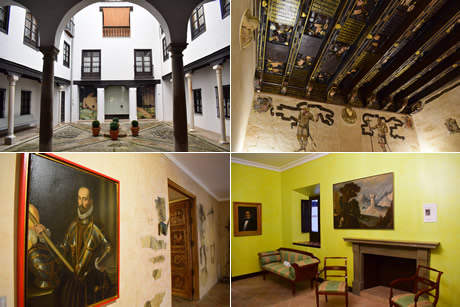
The Casa de los Tiros (House of Muskets) in Granada may look like an ancient fortress, but it was the palace of a important and very old Granada family: the Granada-Venegas.

Enjoy a special day at the Alhambra with a guided tour
 Alhambra and Nasrid Palaces: discover the wonders of the Alhambra with this all-inclusive tour: the Nasrid Palaces, the Generalife, the Alcazaba, and more.
Alhambra and Nasrid Palaces: discover the wonders of the Alhambra with this all-inclusive tour: the Nasrid Palaces, the Generalife, the Alcazaba, and more.
 Alhambra + Albaicín + Sacromonte: a perfect combination of a guided tour of the Alhambra in the morning and a guided tour of the Albaicin and Sacromonte in the afternoon.
Alhambra + Albaicín + Sacromonte: a perfect combination of a guided tour of the Alhambra in the morning and a guided tour of the Albaicin and Sacromonte in the afternoon.They were direct descendants of the Nasrid royal family and converted to Christianity when the city was taken by the Catholic Monarchs.
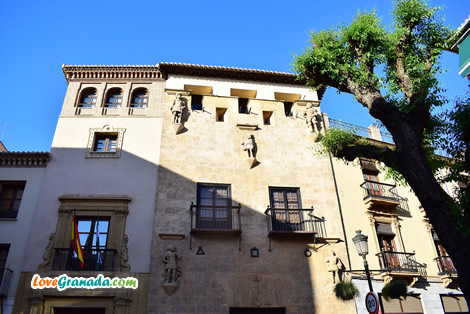 They managed to remain an influential family and retained much of their power
thanks to marriage links with the new Christian elites.
They managed to remain an influential family and retained much of their power
thanks to marriage links with the new Christian elites.
The Casa de los Tiros de Granada was probably built between 1530 and 1540.
Its fortified appearance is due to the fact that it was part of the wall that was in the neighborhood of the Potters in the 16th century (as occurs with the Royal Room of Santo Domingo).
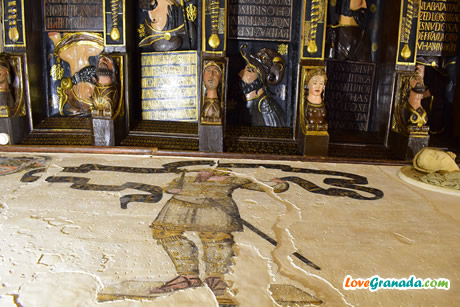 In 1929, it became public property, thanks to the favorable resolution by the Spanish State
of a long dispute that was maintained with the Marquises of Campotéjar, descendants of the Granada-Venegas already
related to European royal families.
In 1929, it became public property, thanks to the favorable resolution by the Spanish State
of a long dispute that was maintained with the Marquises of Campotéjar, descendants of the Granada-Venegas already
related to European royal families.
Fortunately, the Generalife was also recovered in this resolution.
It is known as the Generalife lawsuit.
Why is it called Casa de los Tiros?
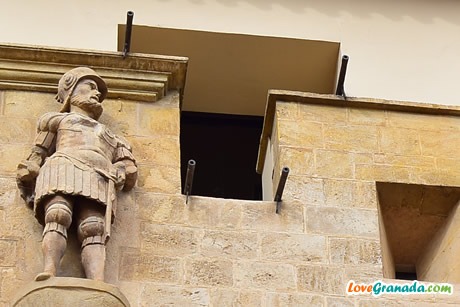 From the outside, the Casa de los Tiros is seen as a square tower ending in
battlements from which ancient muskets protrude (a type of weapon from the 16th century),
and that's where the name of the house comes from.
From the outside, the Casa de los Tiros is seen as a square tower ending in
battlements from which ancient muskets protrude (a type of weapon from the 16th century),
and that's where the name of the house comes from.
The stone façade is simple yet elegant and imposing.
The stone façade is adorned with notable high-relief sculptures, depicting gods such as Hercules, Theseus, Hector, and Jason, all clad in Roman attire.
 Mercury is also shown wearing clothes like a herald and a dalmatic with the family's coat of arms.
Mercury is also shown wearing clothes like a herald and a dalmatic with the family's coat of arms.
Below the two balconies, you'll find three bronze knockers, each supported by hearts. Each knocker is unique, with family legends inscribed on them.
Above the main door's large lintel, a carved sword pointing towards a heart welcomes the visitor.
It is the crest and family motto of the Granada-Venegas: "He commands" (referring to the heart).
Rooms at the Museum Casa de los Tiros
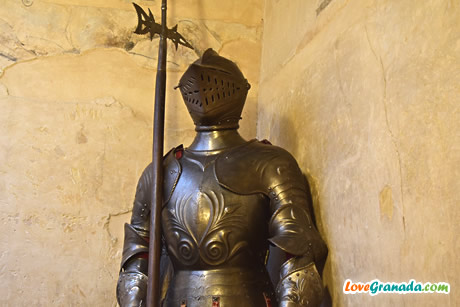
- Golden room
- Room 1. Manuel Ángeles Ortiz
- Room 2. Orientalism I
- Room 3. Orientalism II
- Room 4. The travelers
- Room 5. Industrial arts and Barros collection
- Room 7. Customs, manners, and everyday life
- Room 9. Elizabethan room
- Room 10. The woman of Granada and the culture
- Room 12. Great events
What See in the Casa de los Tiros
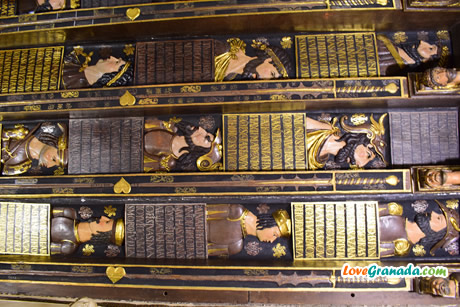 The Casa de los Tiros has a spacious and rather unadorned entrance or hallway.
The Casa de los Tiros has a spacious and rather unadorned entrance or hallway.
The ceiling beams are upheld by Gothic-style supports, with exquisite paintings adorning the spaces in between, depicting mythological animals and wild beasts in combat.
The courtyard in Muslim style beautifully retains the original Nasrid columns.
The main living room, known as the Golden Room, is the highlight of the original house. Its magnificent wooden ceiling, intricately carved and adorned with polychrome details, features swords carved into the beams.
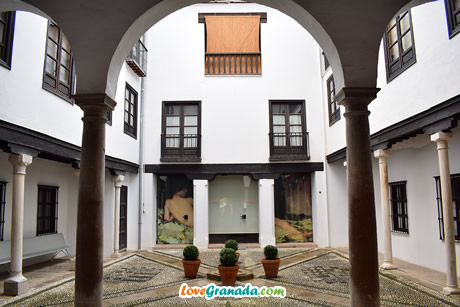 The supports for these massive beams are adorned with carved heads of kings and heroes,
featuring Spanish inscriptions that allude to their exploits.
The supports for these massive beams are adorned with carved heads of kings and heroes,
featuring Spanish inscriptions that allude to their exploits.
On the walls, remnants of mural paintings depicting heroes and warriors are visible, along with four relief figures portraying heroines of antiquity.
Pay attention to the beautiful Plateresque-style wooden doors.
Other interesting parts of the house include a smaller, unusable staircase from the 16th century with remnants displaying beautiful pictorial decoration on the walls.
 The second staircase, from the 18th century, features a stunning dome and portraits of the Spanish
kings of the House of Austria.
The second staircase, from the 18th century, features a stunning dome and portraits of the Spanish
kings of the House of Austria.
The small and beautiful garden is currently closed, but it hosts occasional celebrations, concerts, and other cultural events.
In the different rooms of the house, including the modern part added later, a valuable collection of paintings and sculptures related to the history of Granada is displayed. These artworks belong to important local artists.
The City Museum
 Currently, the Casa de los Tiros houses one of the least known yet most interesting museums in Granada.
Currently, the Casa de los Tiros houses one of the least known yet most interesting museums in Granada.
Created under the direction of Antonio Gallego Burín, one of the most prominent figures in the conservation of Granada's heritage, soon they began to rescue drawings, engravings, photographs, pieces of local crafts, bibliographical collections on local themes, posters, brochures, etc...
His collection was completed with the private archives of Granada personalities who donated them, as Gallego Burín himself did, or they were purchased.
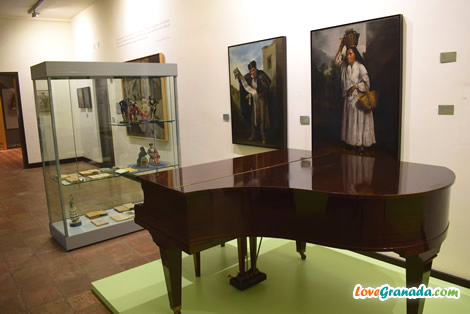
Second Floor, Rooms I-VIII
The visit begins on the second floor. In Room I , we see the city through the eyes of different artists, both local and foreign.There are beautiful and interesting paintings by artists such as Manuel Ángeles Ortiz, as well as engravings made by Joris Hoefnagle around 1565.
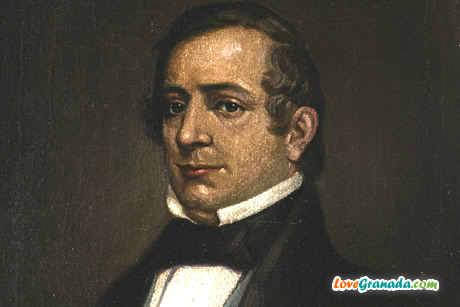 In Rooms II and III, we delve into Orientalism, an artistic movement inspired
by the Alhambra that brought international fame to Granada. The inlay pieces are impressive, with a
particular highlight being the 17th-century bargueño (desk or cabinet).
In Rooms II and III, we delve into Orientalism, an artistic movement inspired
by the Alhambra that brought international fame to Granada. The inlay pieces are impressive, with a
particular highlight being the 17th-century bargueño (desk or cabinet).
Room IV is dedicated to romantic travelers who arrived in Granada in the 19th century, including Washington Irving, whose portrait is on display.
In Rooms V and VI, a wide variety of Granada crafts is showcased, including Alpujarran fabrics, brass lanterns, and, above all, exquisite Granada ceramics from Fajalauza dating back to the 18th century.
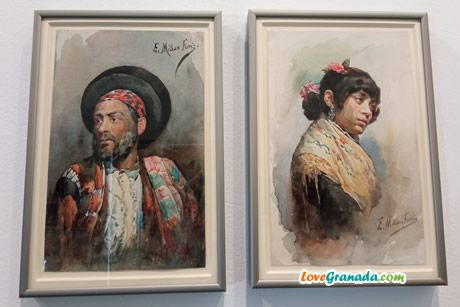 Room VII pays tribute to the people of Granada, their music, and traditions. It embraces
costumbrismo (portrayal of local customs, traditions), a cultural movement prevalent in Spanish culture
during the 19th century
Room VII pays tribute to the people of Granada, their music, and traditions. It embraces
costumbrismo (portrayal of local customs, traditions), a cultural movement prevalent in Spanish culture
during the 19th century
Here we see photographs of the Granada bullfighter Frascuelo and the famous gypsy Chorrojumo, as well as watercolors by Luis Muriel representing everyday scenes in the Plaza Bib-Rambla or the night watchman, etc...
First Floor, Rooms IX - XII
On the first floor are rooms IX to XII, which are currently temporarily closed. Room IX is dedicated to the women of Granada. It displays documents and photos of the most prominent women of the time.
Room IX is dedicated to the women of Granada. It displays documents and photos of the most prominent women of the time.
Room X provides us with testimony of the cultural life of Granada in the 19th century. Room XI documents the historical evolution of Granada through the local press.
Room XII is focused on the city's main festival: the Corpus Christi, featuring numerous interesting posters and lithographs.
Ground Floor
 On the ground floor is the temporary exhibition room.
On the ground floor is the temporary exhibition room.
It can be visited from Tuesday to Saturday, from 11:00 a.m. to 2:00 p.m. and from 5:30 p.m. to 7:30 p.m. On Sundays and holidays, it is open from 11:00 a.m. to 2:00 p.m.
The Casa de los Tiros also houses an important library, archive, and newspaper collection specialized in the Granada press since the 18th century.
These significant resources are available for consultation by appointment.
Opening Hours of the Casa de los Tiros
Casa de los Tiros (House of Muskets) is open:From June 16 to September 15
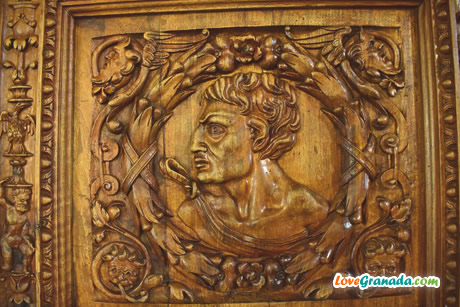
- From Tuesday to Sunday: from 9:00 to 15:00.
- Holidays: from 9:00 a.m. to 3:00 p.m.
- Monday: closed (except Mondays before holidays).
From September 16 to June 15
- From Tuesday to Saturday: from 09:00 to 21:00.
- Sundays and Holidays: from 09:00 to 15:00.
- Mondays: closed (on Mondays before holidays, it opens with holiday hours).
- Note: The museum is closed on January 1 and 6, May 1, and December 24, 25, and 31.
Admission Price and How to Reach the Museum
 Entry to the Casa de los Tiros Museum is free for citizens of the EU with accreditation.
Entry to the Casa de los Tiros Museum is free for citizens of the EU with accreditation.
Other countries €1.50.
How to Get There
Address: Casa de los Tiros, Calle Pavaneras 19, Granada.Phone: 958 221 072.
You can reach the Casa de los Tiros by bus number C31, C32 and C34.
More information at Buses of the Alhambra.
Page Updated: Jul 08, 2025
Was this useful? Been to these sights? Share your thoughts!
© Copyright •
LoveGranada.com • Any use of the content, including copying of it in whole or in part is prohibited.
You Might Also Be Interested In
Opinions about Casa de los Tiros in Granada
Interesting museum but no description in English
Casa de los Tiros is a historic building built in 1530, great example of Renaissance but not quite a palace, from outside has a fortress-like appearance.
Many important artefacts and paintings showing the history of Granada and various exhibits showing recent history of the city. For me the best objects are the portraits of the Catholic Kings along the stairs.
It takes about a half hour to see the museum. Unfortunately all information is in Spanish. Some objects are without description.
The entrance is 1.50 euros, free for EU citizens.
Good collections of paintings and sculptures
A 16th century old Moorish building, inside its stone walls are paintings of ancient warriors in the plaster and amazing ceiling. Only one tower survived from the original building.
Offers collections of sculptures, paintings, portraits of Spanish monarchs and pottery. But the most interesting part is a hall called Cuadra Dorada. Other parts of the museum are less interesting.
Interesting also the ceremonial sword of Boabdil, the last Nasrid king of Granada.
The best area is Cuadra Dorada
It is a little local history museum, used to be a noble's house, one of the first houses of this type built after the conquest of Granada by Catholic Monarchs.
Have portraits of the Catholic monarchs and Andalusian crafts. Probably the highpoint is Cuadra Dorada (Hall of Gold), a room with gold carved wooden ceiling with the stars and decorated stone walls.
Located in the Realejo district near the city centre of Granada. No information posters are in English.

